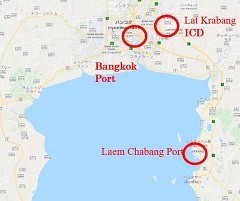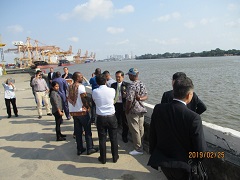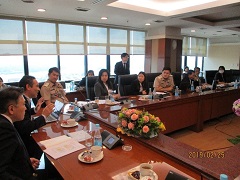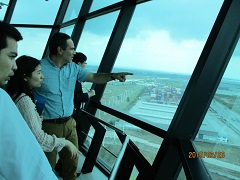- Home
- About JICA
- Organization
- Domestic Offices
- Yokohama Center
- Topics & Events
- [Training Report] Overseas Supplementary Training in Thailand under the Knowledge Co-Creation Program "Strategic Port Administration and Management"
Topics & Events
April 9, 2019
[Training Report] Overseas Supplementary Training in Thailand under the Knowledge Co-Creation Program "Strategic Port Administration and Management"
 The Kingdom of Thailand: Surroundings of Bangkok Bay
The Kingdom of Thailand: Surroundings of Bangkok Bay
JICA Yokohama organizes a training course titled the "Strategic Port Administration and Management" in the port sector, with participation by officials working for port and harbor management in public administration from Asian, Pacific, and African countries. The course is designed such that the participants learn Japan's experience on port development, management and operation, thereby utilizing the acquired knowledge for strategic development and proper management and operation of ports in their countries.
This course is composed of training in Japan as well as "Overseas Supplementary Training" in a third country. It aims to deepen participants' understanding, in addition to that gained in the training in Japan, on port development and management implemented under various circumstances and conditions by observing ports in a third country which has different conditions from Japan.
This time Thailand was selected for a training site, in view that the country offers one of the successful examples of port development in developing countries which had been supported by the Japanese government and had been undertaken with the involvement of Japanese companies. The training participants were given opportunities to learn about coastal development in Eastern Thailand and to attend a workshop along with officials from the Port Authority of Thailand. They were intended to assist and guide the participants to make use of what they learned in both Japan and Thailand after they go back to their countries.
From February 24 - 28 of this year, two experts of the Overseas Coastal Area Development Institute of Japan joined 14 participants in Bangkok, Thailand to conduct the supplementary training. During the training, the experts and participants visited different sites including the Bangkok Port, the Laem Chabang Port, and the Lat Krabang ICD (Inland Container Deport) and shared experiences.
Bangkok Port
Bangkok Port is a river port located about 30 km from the mouth of the Chao Phraya River and close to an urban area. Bulk carriers are docked at the west side of the Port while container vessels of 10,000 - 12,000 DWT are at the east side of the Port. The Port has been in operation for more than 60 years as a base of maritime transport in Thailand.
The participants visited the Port and observed its operation. At the workshop, officials from the Port Authority presented their future development policy and exchanged views and opinions on port development with the participants. It seems that the Port Authority has an idea of taking Yokohama Port as a model to redevelop Bangkok Port.
 Observing Bangkok Port
Observing Bangkok Port
Holding a discussion with local officials on port operation
 At workshop
At workshop
A lively discussion was held between the participants and officials from the Port Authority of Thailand.
Laem Chabang Port
 At the port tower in the Laem Chabang Port
At the port tower in the Laem Chabang Port
Participants overlooking Laem Chabang Port, which facilitated their better understanding
Laem Chabang Port is an international port which is most closely located to the open sea among the ports in Bangkok Bay. There were restrictions imposed on the expansion of hinterland of Bangkok Port. In light of this, JICA conducted many development surveys in the area. Later Thailand accepted Japan's proposal to develop the Port based on the comprehensive development project of Kashima Port, which was to develop the port in harmony with local industries. Japan provided strong support both technically and financially. Japanese companies operating in Thailand have contributed to the development of the Thai economy by creating employment opportunities and exporting their products. The Port has become the largest port in Thailand by volume of cargo handled, overtaking Bangkok Port.
The participants overlooked the whole Port from a port tower in Laem Chabang Port. As they had been explained about their future development plan by the Port Authority officials in advance, the visit produced significant effects. Some participants stated that the Port was very similar in structure to Japanese ports. Then, they visited the NYK (Nippon Yusen Kabushiki Kaisha) terminal and learned the operation of ro-ro vessels and cruise ships. Attention should be given to the future development of this Port along with Japanese companies' engagement in its process.
Lat Krabang ICD
Lat Krabang ICD is located northeast of Bangkok Port. While it is located on the outskirts of Bangkok, it plays a role to alleviate traffic congestion by using a railway concurrently. The railway is directly connected to Laem Chabang Port and is mainly used for inland transport from Laem Chabang Port to Bangkok.
The participants visited the State Railway of Thailand, receiving an explanation about the roles of railway transport in the country. Later, they visited ESCO, a container terminal operation company, and observed an operation room inside the ICD. They were interested in the ICD as one of the ways to manage containers.
During the training in Japan, the participants developed action plans (plans on what to implement) on activities to implement after returning to their countries. They are expected to integrate what they learned during the overseas supplementary training into their action plan after they go back to their countries. It is expected that the action plan that they develop will be reflected on port development of which they are in charge, thereby contributing to their future development.
(Prepared in cooperation with Overseas Coastal Area Development Institute of Japan)
- About JICA
- News & Features
- Countries & Regions
- Our Work
- Thematic Issues
- Types of Assistance
- Partnerships with Other Development Partners
- Climate Change / Environmental and Social Considerations
- Evaluations
- Compliance and Anti-corruption
- Science and Technology Cooperation on Global Issues
- Research
- JICA Development Studies Program / JICA Chair
- Support for the Acceptance of Foreign HRs / Multicultural and Inclusive Community
- Publications
- Investor Relations
